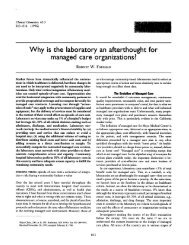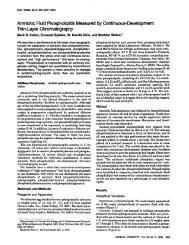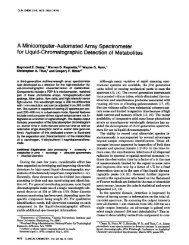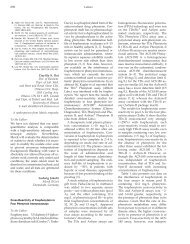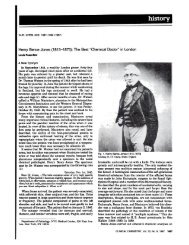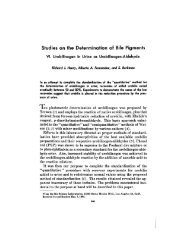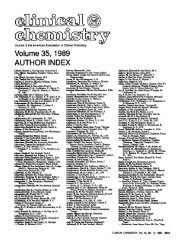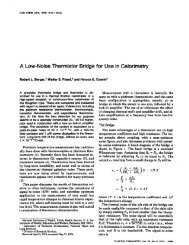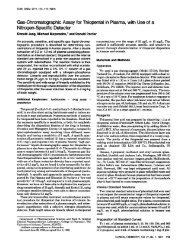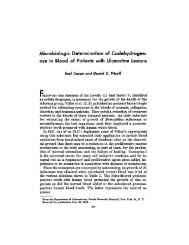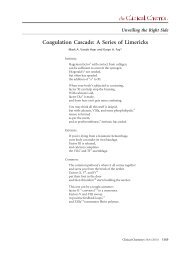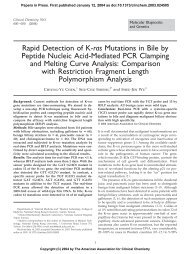A Clinical Evaluation of Various Delta Check ... - Clinical Chemistry
A Clinical Evaluation of Various Delta Check ... - Clinical Chemistry
A Clinical Evaluation of Various Delta Check ... - Clinical Chemistry
You also want an ePaper? Increase the reach of your titles
YUMPU automatically turns print PDFs into web optimized ePapers that Google loves.
‘iv 103 Obtained<br />
Fig. 1. <strong>Delta</strong> check evaluation algorithm<br />
Yes False Positive<br />
No ,True Positive<br />
False Positive<br />
than to TR1, TR2 was considered to be correct and the delta<br />
check failure was specified to be a false positive.<br />
If the TR3 was closer to TR1 than to TR2, or if a TR3 was<br />
not obtained, the second step in the algorithm was carried out.<br />
This step included performing a repeat SMA 6 determination<br />
on the TR2 specimen (when there was sufficient specimen).<br />
The results <strong>of</strong> this determination is designated TR2R. When<br />
the difference between TR2 and TR2R exceeded three times<br />
the standard deviation <strong>of</strong> the corresponding test method, a<br />
laboratory test-performance error was judged to have occurred<br />
and the delta check failure was designated a true positive. If<br />
TR2R validated TR2 or if sufficient specimen was not available<br />
to perform a repeat determination, the third step <strong>of</strong> the<br />
algorithm was performed.<br />
The third step <strong>of</strong> the algorithm was to review the patient’s<br />
chart. This review focused on a search for the etiology <strong>of</strong> the<br />
delta. Examples <strong>of</strong> some clinical situations that we accepted<br />
as being the cause <strong>of</strong> large changes in SMA 6 test results<br />
are:<br />
1. Renal dialysis done between the time the two specimens<br />
were drawn.<br />
2. Potassium supplementation given (as a reason for a<br />
increase).<br />
3. Recent renal transplant as a reason for decreasing urea<br />
nitrogen and creatinine (normal pattern) or increasing<br />
urea nitrogen and creatinine (rejection).<br />
4. Intravenous therapy with an electrolyte-containing<br />
fluid.<br />
Because we investigated only those test results that failed<br />
one or more <strong>of</strong> the delta check methods, we cannot divide the<br />
test results that did not fail a particular delta check into true<br />
and false negatives with total accuracy. However, in several<br />
cases a test result that did not fail one method did fail one or<br />
both <strong>of</strong> the other methods and was therefore investigated, so<br />
we can assign these delta check failures to be true or false<br />
negatives. Further, if it is assumed that all “medically significant”<br />
changes in test result values will be detected by one<br />
<strong>of</strong> the three methods, true and false negative percentages can<br />
be computed for all the test result delta check combinations<br />
except urea nitrogen/creatinine ratio and anion gap, which<br />
were evaluated only by the Wheeler-Sheiner method. This<br />
assumption yields a lower bound for the false-negative percentage<br />
rates, because two classes <strong>of</strong> undetected test result<br />
errors will not be included. The first is the “small” error (e.g.,<br />
reporting a K result that was actually determined to be 3.2<br />
mmolfL as 3.4 mmol/L). This clearly is an error, but it should<br />
6 CLINICAL CHEMISTRY, Vol. 27, No. 1, 1981<br />
liv<br />
No<br />
No<br />
No judgenmnt<br />
made<br />
UN Tests Failing The<br />
Wheeler-Shelner Method (27)<br />
True Positive<br />
No (I)<br />
False Positives<br />
True Positives<br />
False Positives<br />
Fig. 2. <strong>Delta</strong> check evaluation algorithm results for the<br />
Wheeler-Sheiner delta check methodapplied to urea nitrogen<br />
test results<br />
have no impact on patient case. Another example <strong>of</strong> this type<br />
<strong>of</strong> error would be a switch <strong>of</strong> labels on specimens from two<br />
patients with “normal” values for electrolytes, urea nitrogen,<br />
and creatinine. All the results would be in error, but they<br />
might not differ sufficiently to trigger a delta check failure.<br />
The second type <strong>of</strong> test result error that would not be included<br />
in the false-negative calculation is one in which the true<br />
test result differs greatly from the previous test result, but the<br />
erroneous test result is nearly the same. For example, yesterday’s<br />
K+ result was 4.0 mmol/L and the true value for today’s<br />
K+ value is 6.0 mmol/L, but an error is made such that<br />
a value <strong>of</strong> 3.9 mmol/L is reported. <strong>Delta</strong> check methods are<br />
by definition unable to detect this type <strong>of</strong> error.<br />
Despite the above problems, we believe that method performance<br />
estimates based on this assumption are useful, because<br />
“small” errors are not <strong>of</strong> clinical importance and the<br />
second type <strong>of</strong> error should be relatively rare.<br />
Results<br />
A total <strong>of</strong> 707 sets <strong>of</strong> SMA 6 results (including the urea nitrogen/creatinine<br />
ratio and anion gap) were included in the<br />
study. Of these, 253 had an SMA 6 analysis performed within<br />
0.9 to 2.5 days previously and therefore satisfied the criterion<br />
for delta check evaluation. Of these 253 sets <strong>of</strong> SMA 6 results,<br />
150 (59%) had at least one test result that failed one or more<br />
<strong>of</strong> the three delta check methods. The algorithm described in<br />
Figure 1 was followed in all the cases. Figure 2 presents the<br />
results <strong>of</strong> this process for urea nitrogen test results that failed<br />
the Wheeler-Sheiner delta check. A total <strong>of</strong> 27 test results<br />
failed the Wheeler-Sheiner delta check. Of these, 17 were<br />
judged to be false positives because the result <strong>of</strong> a determination<br />
made on a specimen on the next day (TR3) was nearer<br />
to TR2 than TR1. Three results had TR3 values nearer to TR1<br />
than TR2, and in seven cases a urea nitrogen determination<br />
was not done the next day. The 10 specimens in the two latter<br />
groups were candidates for repeat tests (i.e., obtaining TR2R<br />
values).<br />
In one case the repeat determination was not done. The<br />
reason repeat determinations were not done was not recorded<br />
for each case; however, the reason was usually that an insufficient<br />
volume <strong>of</strong> specimen was available. In two cases the<br />
TR2R value exceeded three test-method standard deviations<br />
from TR2. In these cases the repeat value was judged to in-




